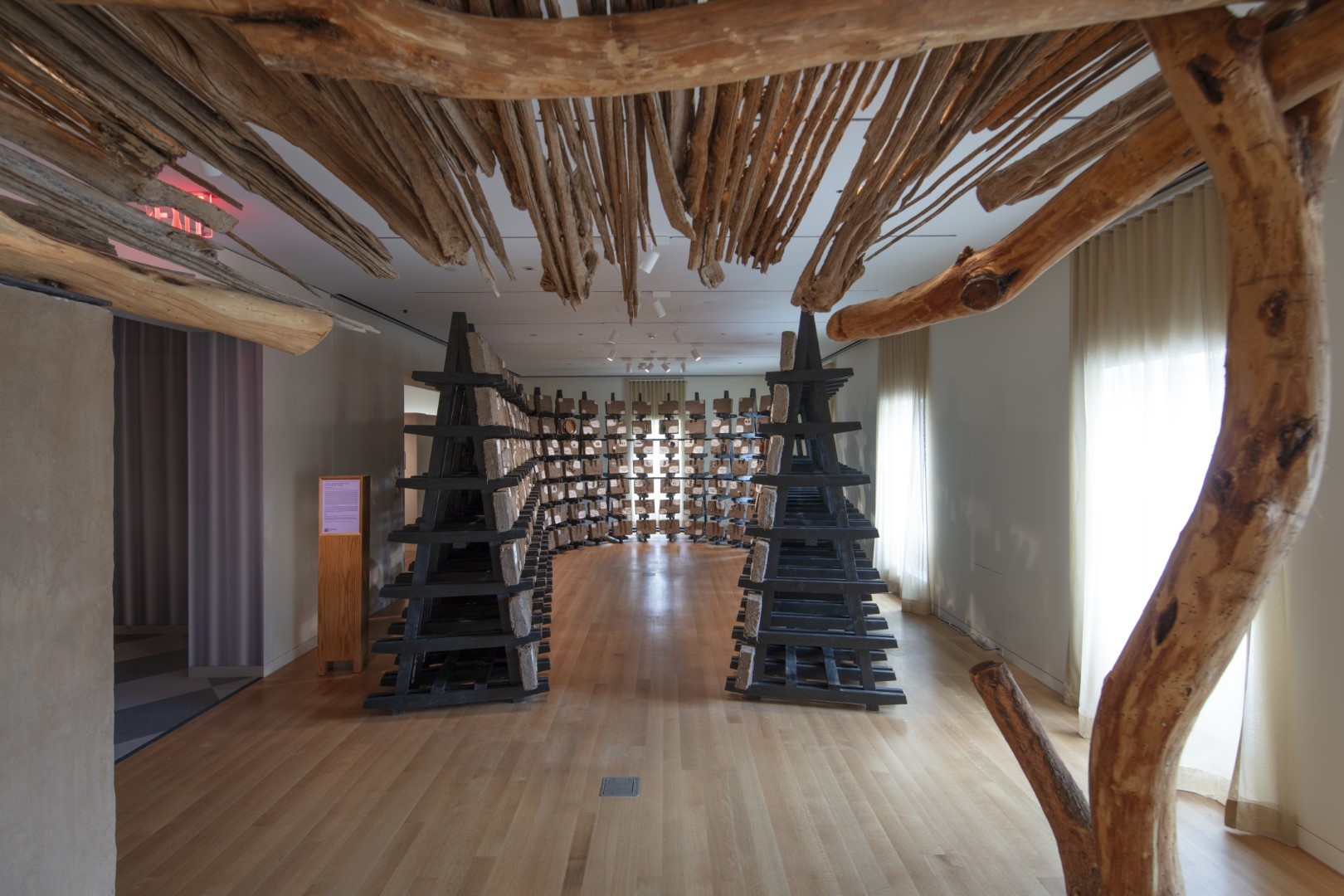CASA DESENTERRADA/EXHUMING HOME

ABOUT THE INSTALLATION
RONALD RAEL
BORN 1971, LA FLORIDA, COLORADO;
ACTIVE BERKELEY, CALIFORNIA, AND LA FLORIDA, COLORADO
In 2018, designer Ronald Rael rescued an abandoned adobe home in Conejos, a town in the San Luis Valley region of southern Colorado, from the threat of demolition. Rael, a native of the area, began an ongoing initiative to preserve the structure and uncover the decades of history that had transpired at the site. The home was constructed in 1855, by former US soldier Lafayette Head, in an attempt to claim the Conejos Land Grant following his service in the Mexican-American War (1846–1848). Once a large, fortified adobe compound, the house was both his residence, his office as the first Lieutenant Governor of Colorado, and the headquarters of the Ute Indian Agency. Head served here as a US Indian Agent to the Uncompahgre (Tabeguache) Ute people, whose seasonal home was in Conejos. In 1868, three years after the end of the Civil War, Head was tasked by the US government with documenting the unlawful enslavement of Indigenous people in southern Colorado. He produced a census listing 149 names of children as well as young men and women who, through war or trade, had been abducted from their Native communities and forced into servitude in the homes of Hispano families. Although Head publicly denounced this practice, he enslaved Indigenous laborers in his own home. These detribalized Indigenous people, who were referred to as Genízaros, would go on to form kinships among themselves or marry into Hispano families.
For Casa Desenterrada, Rael exhumed a portion of the Ute Indian Agency that was demolished and buried in the 1960s and reconstitutes the material to create the adobe bricks of this structure. A soundtrack whispering the names of the people enslaved in the region serves as a tribute to them and their descendants who continue to live in the San Luis Valley. The adobe bricks display the names of those listed in Head’s census, objects excavated from the site, and images of the people and buildings of Conejos.
ACCESSIBILITY RESOURCES
Casa Desenterrada/Exhuming Home is installed on a large black wooden structure, roughly 10 feet tall, nearly reaching the ceiling. The circular structure is filled with seven rows and dozens of columns of 300 adobe bricks in total, each roughly thirteen by nine inches, that sit upon the inside of the wooden structure. The structure is strategically built in the shape of an elongated horseshoe which creates a curving grid of adobe bricks that allows the viewer to walk inside for an immersive experience. The structure is made of tall vertical wooden planks that come to a point, attached in a triangular shape so that the adobe bricks resting on the planks running throughout the structure can lean back slightly. The structure is open, with empty space around each brick letting them breathe as they perch on the ledges of the planks. Arriving from the long main hallway on the 3rd floor, the installation is on a light wood floor surrounded by white walls, and the opening to the wood structure is to our left. Directly across to our right in the open gallery space is another installation, We:sic ’em ki: (Everybody’s Home).
As we enter to our left, we see that each of the bricks is unique. The bricks are all light grayish brown and bits of hay stick out from the dried roughly textured mud. Many of the bricks have one or two corners painted with a curved area of white on the surface that faces the viewer. While several bricks are completely blank and several only have the white paint on their surface, many of the bricks also have names written in nineteenth century black cursive letters on top of the white paint. In some places they are a bit hard to read due to faded ink and the style of writing. Various small objects excavated from the site of the demolished Ute Indian Agency have also been secured to the surface of many of the bricks. The objects which appear as remnants or fragments are placed both inside and outside of the painted white corners. Each brick has its own compositional logic. Looking all around the installation we notice objects such as an old horseshoe, shards of light blue glass, small glass bottles, a rusty wire coil, a set of 6 different buttons, a metal pan, a jawbone of an animal and other bits of bones, a broken rusty fork, a small Catholic book with a tattered black cover titled “Mi Misal Dominical”, lots of broken pieces of ceramics, what seems to be torn pieces of floral wallpaper, and other small excavated objects. We also notice that some bricks include images that have been transferred and embedded onto the adobe, taking on the rough texture. The images are small and require close looking. We see large old buildings and portraits. Many of the portraits are of Indigenous people wearing traditional clothing. Some images show people seated for a portrait with a partner. Other images show groups of Indigenous people and white men in suits.
Acknowledgements
Adobe installation was created with the support of Teddy Andriese, Emmanuel Carrillo, William Farmer, Ryan Gallegos, Michael Jiron, Rayoung Kim, and Elliott Surber.
Special thanks to Julie Chacon, Eric Carpio, Dawn di Prince, Kim Grant, Joanna Keane Lopez, Loretta Mitson, Katie Pearson, Christine Rael, Estevan Rael-Gálvez, Mattias Rael, Chip Thomas, Rio de la Vista Colorado Preservation Inc., History Colorado; The County of Conejos; The Sangre de Cristo National Heritage Area, Native Bound Unbound, and The University of California, Berkeley.